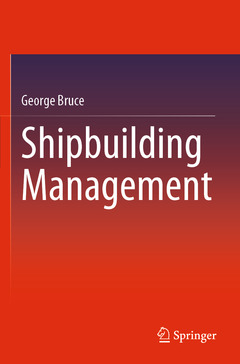Shipbuilding Management, 1st ed. 2021
Auteur : Bruce George

This book highlights the main features of shipbuilding management which lead to successful completion of shipbuilding projects. A brief review of the market context for the industry, its historical development are given to explain how shipbuilding arrived at its current structure. First pre-production including design, planning, cost estimating, procurement of materials and sub-contracting. Then, the production sequence outlines part preparation, hull assembly and construction, outfitting and painting, testing and completion. The importance of human resources and management organisation are explained. Building a ship is a complex project, so the principles of project management are described, first in general terms and then with specific reference to their application in shipbuilding. Finally managing the progress of a shipbuilding project and achieving completion are emphasised.
Part 1 Shipbuilding Context
Chapter 1. The shipbuilding market.
This will summarise the development of different types of ship, international and local markets, volatility in the market.
Chapter 2 Development of Shipbuilding
A brief review of major changes over 200 years. The development of steel ships, increases in size, propulsion including steam, motor and electric ships, increased complexity in equipment. How the changes have affected the industry.
Part 2 Pre-production Requirements
Chapter 3 Ship Design
The design process is outlined, from marketing to final detail. The importance of design for production is emphasised.
Chapter 4 Planning
Planning effectively starts when a prospective contract is identified. As the design develops, along with materials requirements, the plans are developed in increasing detail.
Chapter 5 Materials Procurement
Historically shipyards made most materials and equipment required for a ship. As the ships became larger and more complex, increasing use of specialist suppliers made procurement increasingly important. The need to reduce costs and reduce the time to build a ship have also driven the need for efficient procurement
Chapter 6 Sub-Contractors
Shipyards also employed all the necessary skills, but again the increased complexity and need for cost reduction have led to the use of specialist sub-contractors
Part 3 Ship Construction
Chapter 7 Shipyard Facilities and Equipment
How the development of ships, and the need to build larger and more complex ships quickly has led to the modern shipyard. Main facilities are described, including workshops, docks, cranes and major items of production machinery.
Chapter 8 Hull Part Preparation
A description of the processes in developing a hull design which is satisfactory for size and strength into the detail needed for part production. A description of the equipment used
Chapter 9 Hull Assembly
The steel parts are assembled into structures (sub-assemblies, units, blocks) which when complete will be added to the ship hull structure. The benefits and problems of different methods are described
Chapter 10 Ship Construction
The final construction of the ship, usually in a dry-dock and using large structures to shorten the time taken is described
Part 4 Ship Outfitting and Testing
Chapter 11 Pipe and other systems
Although described separately for convenience the installation of ship systems is integrated with the hull. Production of parts, assembly and installation are described especially completing the work as efficiently as possible
Chapter 12 Equipment Installation
The equipment is bought from specialist suppliers and often installed by them. Installing equipment in packages which are partly tested in advance is described
Chapter 13 Painting
Modern coatings have been developed for corrosion protection, fuel efficiency and minimal environmental impact. Their correct application is important, given the cost and required lifespan.
Chapter 14 Testing
The ship and all installed systems have to be working properly prior to delivery. A comprehensive test programme is needed to ensure this is achieved
Chapter 15 Completion
The ship is completed when it is fully ready for sea-going operation. This includes significant documentation, including operating manuals, regulatory approvals and classification
Part 5 Project Management
Chapter 16 Principles of project management
An overview of the key principles which lead to a successful project when correctly applied.
Chapter 17 Shipbuilding Projects
Application of project management to shipbuilding requires specific aspects of the industry to be considered. The variety of projects in shipbuilding is discussed and how their management can vary.
Chapter 18 Quality Assurance
All the processes described require quality assurance. The topic is outlined, including ensuring equipment is fit for purpose, that parts are accurate to ensure rapid assembly and the finished work is correct.
Highlights the main features of shipbuilding management leading to successful completion of shipbuilding projects
Outlines the principles of project management, first in general terms and then with specific reference to their application in shipbuilding
Reviews the market context for the industry and presents its historical development
Date de parution : 12-2021
Ouvrage de 216 p.
15.5x23.5 cm
Date de parution : 12-2020
Ouvrage de 216 p.
15.5x23.5 cm


